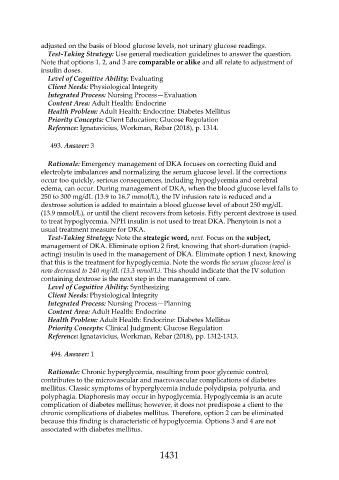Page 1431 - Saunders Comprehensive Review For NCLEX-RN
P. 1431
adjusted on the basis of blood glucose levels, not urinary glucose readings.
Test-Taking Strategy: Use general medication guidelines to answer the question.
Note that options 1, 2, and 3 are comparable or alike and all relate to adjustment of
insulin doses.
Level of Cognitive Ability: Evaluating
Client Needs: Physiological Integrity
Integrated Process: Nursing Process—Evaluation
Content Area: Adult Health: Endocrine
Health Problem: Adult Health: Endocrine: Diabetes Mellitus
Priority Concepts: Client Education; Glucose Regulation
Reference: Ignatavicius, Workman, Rebar (2018), p. 1314.
493. Answer: 3
Rationale: Emergency management of DKA focuses on correcting fluid and
electrolyte imbalances and normalizing the serum glucose level. If the corrections
occur too quickly, serious consequences, including hypoglycemia and cerebral
edema, can occur. During management of DKA, when the blood glucose level falls to
250 to 300 mg/dL (13.9 to 16.7 mmol/L), the IV infusion rate is reduced and a
dextrose solution is added to maintain a blood glucose level of about 250 mg/dL
(13.9 mmol/L), or until the client recovers from ketosis. Fifty percent dextrose is used
to treat hypoglycemia. NPH insulin is not used to treat DKA. Phenytoin is not a
usual treatment measure for DKA.
Test-Taking Strategy: Note the strategic word, next. Focus on the subject,
management of DKA. Eliminate option 2 first, knowing that short-duration (rapid-
acting) insulin is used in the management of DKA. Eliminate option 1 next, knowing
that this is the treatment for hypoglycemia. Note the words the serum glucose level is
now decreased to 240 mg/dL (13.3 mmol/L). This should indicate that the IV solution
containing dextrose is the next step in the management of care.
Level of Cognitive Ability: Synthesizing
Client Needs: Physiological Integrity
Integrated Process: Nursing Process—Planning
Content Area: Adult Health: Endocrine
Health Problem: Adult Health: Endocrine: Diabetes Mellitus
Priority Concepts: Clinical Judgment; Glucose Regulation
Reference: Ignatavicius, Workman, Rebar (2018), pp. 1312-1313.
494. Answer: 1
Rationale: Chronic hyperglycemia, resulting from poor glycemic control,
contributes to the microvascular and macrovascular complications of diabetes
mellitus. Classic symptoms of hyperglycemia include polydipsia, polyuria, and
polyphagia. Diaphoresis may occur in hypoglycemia. Hypoglycemia is an acute
complication of diabetes mellitus; however, it does not predispose a client to the
chronic complications of diabetes mellitus. Therefore, option 2 can be eliminated
because this finding is characteristic of hypoglycemia. Options 3 and 4 are not
associated with diabetes mellitus.
1431

